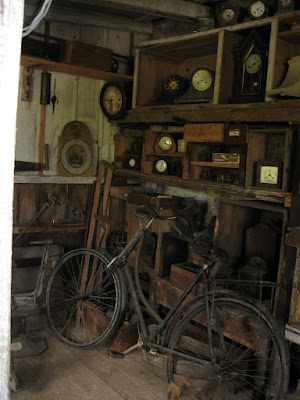In the morning we tackled the Clan Macpherson Museum. First things first: we later discovered that the outside of the building was used in one episode of Monarch of the Glen. This was quite exciting, as we had picked the area because it was Monarch country, so we knew it would be pretty. Lots of the buildings looked like they came right out of the show, because practically every structure in the region was built with the same kind of gray stone.

I had thought Monarch of the Glen depicted the life of a country laird in a way that was, well, highly fictional. And I'm sure that's the case. But the entire feel of the Clan Macpherson Museum was quite reminiscent of the fierce clan pride, obsession with history, peculiar mythology, general lack of funds, and overall self-conscious Scottishness that comes up quite often in the show. When we walked into the museum, we were stopped by a Macpherson and asked, "Are you Macphersons?" No, we were not. "Well, you're welcome anyway," said the Macpherson half-heartedly. Then he had us watched a video on the history of the Macphersons and the museum, in which the current chief of the clan walked around in glens wearing a kilt and looking outrageously aristocratic. It was all quite surreal.
The weather cleared in the afternoon, so we walked a mile or two in the other direction to see the Highland Folk Museum, an open-air museum made up of re-located buildings from various historical periods. A couple of buildings from the turn of the century looked like they'd been banged together out of corrugated metal, and it turned out that was more or less true. Apparently, back in the day, you could order a prefabricated building from a catalogue and BAM: schoolhouse! or BAM: church! They are not pretty, but they're pretty cool.

They had a lot of small shops, the most pleasant of which was the tailor's.

The clockmaker's was a bit dim and dusty.

The schoolhouse seemed quite cheerful until it occured to me that this pronunciation guide was actually a symbol of linguistic oppression.

Most of the children (if I recall correctly) would have spoken Gaelic at home, but were discouraged from using it once they got to school. Fortunately it didn't totally work; north of a certain point it seems like all the English signs have Gaelic translations (which you could damage your vocal chords trying to pronounce, but that's another post).
Then there's a stretch with no buildings, where you walk down The Most Scottish Road Ever, seen here in all its mossy, fir-treed glory.

And then you pass the curling pond and the curling hut, which contains curling stones, all kinds of tools for dealing with ice, a quantity of tweed outerwear, and the all-important supply of whisky.

Then, at the very end, the best part. Oh yes, that's right: thatched-roof hovels!

Alarmingly, these are not replicas of Iron Age homesteads. This is how highlanders lived in the 1700s.

I took a lot of pictures of them.

All of them, but especially that one, make me think of Snufkin from the Moomintroll books.

It must be the hat.
The other end of the museum has the more modern stuff, dating to the forties and fifties, which was less exciting because nothing was thatched. However, I had just read 84, Charing Cross Road, in which the American author sends her friends in England all kinds of rationed food during World War II, so I was somewhat bemused to see the package of eggs in the post office. There is some discussion in the book as to the merits of powdered eggs versus fresh eggs, and I am happy to say that that brown parcel did nothing to enlighten me as to the nature of powdered eggs, which I can only imagine to be revolting.

This was also the farming portion of the museum, where we saw all kinds of unidentifiable equipment. I leave you with this image of feline bliss. I have no earthly idea what it's sleeping on.


1 comment:
if something terrible happens and we can't live in tiny houses when we're old and gray, I think plan B should be living in thatched-roof hovels.
Post a Comment